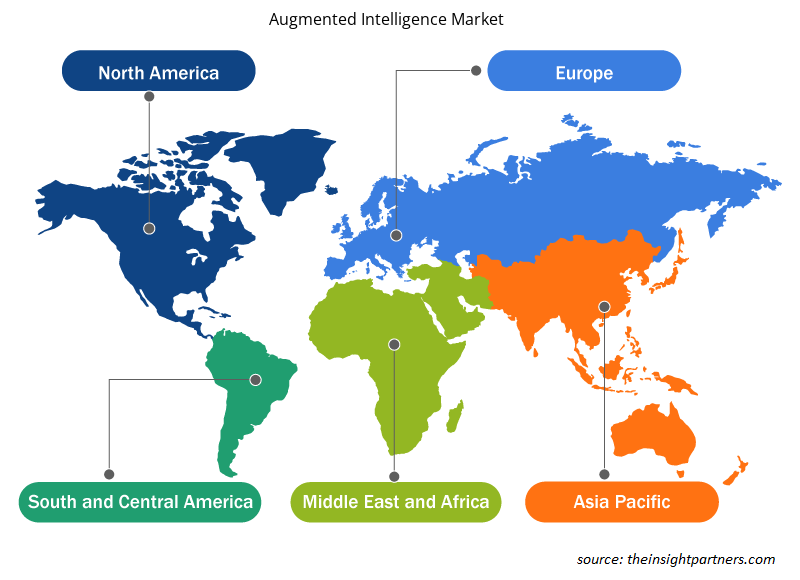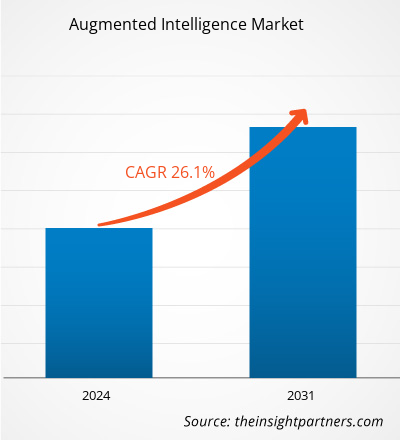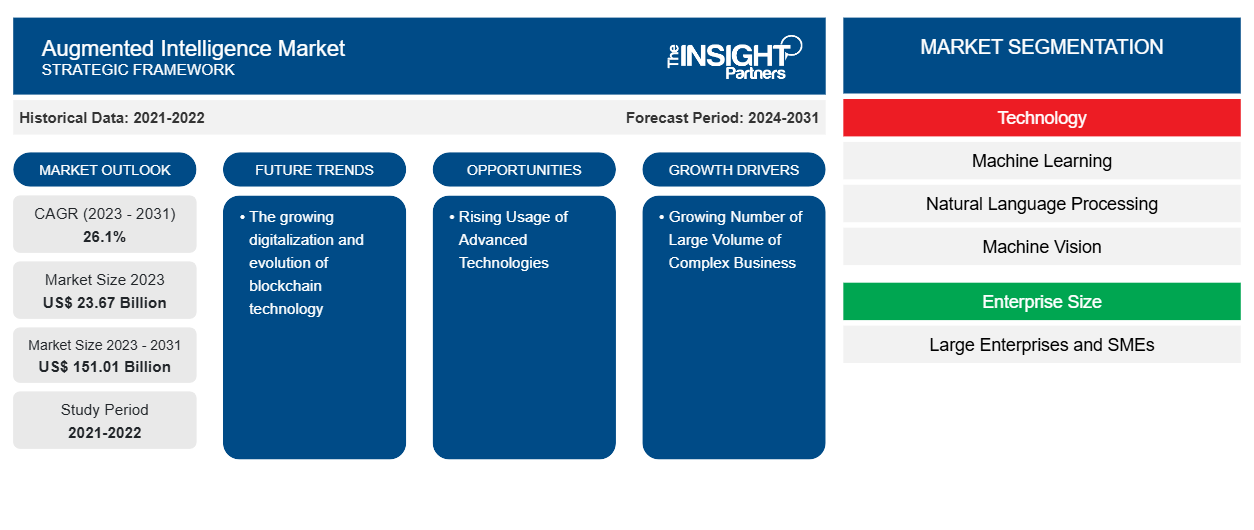Se prevé que el tamaño del mercado de inteligencia aumentada alcance los 151.010 millones de dólares en 2031, frente a los 23.670 millones de dólares en 2023. Se espera que el mercado registre una CAGR del 26,1 % entre 2023 y 2031. Es probable que la creciente digitalización y evolución de la tecnología blockchain sigan siendo una tendencia clave en el mercado de inteligencia aumentada.
Análisis de mercado de inteligencia aumentada
El mercado de la inteligencia aumentada está creciendo a un ritmo rápido debido al creciente número de grandes volúmenes de datos empresariales complejos y a la expansión de las industrias de BFSI, TI y telecomunicaciones, y comercio minorista y comercio electrónico. El mercado se está expandiendo de manera constante, impulsado por la creciente adopción de inteligencia aumentada entre las pymes. Además, el uso creciente de tecnologías avanzadas y la adopción cada vez mayor de soluciones basadas en la nube entre las empresas están brindando oportunidades lucrativas para el crecimiento del mercado.
Descripción general del mercado de inteligencia aumentada
La inteligencia aumentada es un tipo de inteligencia artificial que se centra en las capacidades de asistencia de la IA. Además, la inteligencia aumentada se está creando para ayudar a las organizaciones a tomar decisiones más precisas basadas en datos en los negocios y en la vida diaria. Además, las empresas utilizan la inteligencia aumentada para mejorar el rendimiento de sus empleados y ayuda a la organización a comprender las áreas de mejora de los empleados que impulsan el mercado. Además, la inteligencia aumentada es la técnica más eficaz para utilizar y priorizar una gran colección de datos de seguridad al brindar análisis predictivos a las empresas.
Personalice este informe según sus necesidades
Obtendrá personalización en cualquier informe, sin cargo, incluidas partes de este informe o análisis a nivel de país, paquete de datos de Excel, así como también grandes ofertas y descuentos para empresas emergentes y universidades.
-
Obtenga las principales tendencias clave del mercado de este informe.Esta muestra GRATUITA incluirá análisis de datos, desde tendencias del mercado hasta estimaciones y pronósticos.
Impulsores y oportunidades del mercado de inteligencia aumentada
El creciente volumen de datos empresariales complejos está impulsando el mercado
Las tecnologías de inteligencia aumentada, como el aprendizaje automático y el procesamiento del lenguaje natural, son cada vez más importantes para el análisis de datos. La inteligencia aumentada permite el análisis de fuentes de datos organizados, semiestructurados y no estructurados almacenados en las empresas. Se prevé que la variedad y el gran volumen de datos creados aumenten significativamente en los próximos años, asociados con la expansión de las industrias y la evolución de las tecnologías digitales en las operaciones de las empresas. Esto aumenta la demanda de soluciones de inteligencia aumentada entre las empresas para gestionar de forma eficaz y eficiente su gran volumen de datos. Sin embargo, se prevé que el creciente volumen de datos complicados impulse el mercado de la inteligencia aumentada durante el período previsto.
El uso creciente de tecnologías avanzadas: una oportunidad en el mercado de la inteligencia aumentada
El uso creciente de tecnologías avanzadas como la inteligencia artificial, el aprendizaje automático y las tecnologías de procesamiento del lenguaje natural están creando oportunidades para el crecimiento del mercado durante el período de pronóstico. Muchas industrias, como la TI y las telecomunicaciones, el comercio minorista y el comercio electrónico, BFSI, la atención médica y otras, están generando grandes volúmenes de datos y requieren tecnologías avanzadas para analizar estos datos en tiempo real, lo que aumenta la demanda de soluciones de inteligencia aumentada. Las industrias están adoptando nuevas tecnologías como la inteligencia artificial, el aprendizaje automático y el procesamiento del lenguaje natural para analizar grandes cantidades de datos y tomar decisiones efectivas en tiempo real. Estas herramientas han simplificado el proceso de extracción de información de los datos, lo que aumenta su adopción y crea oportunidades en el mercado.BFSI, healthcare, and others, are generating vast volumes of data and require advanced technologies for analyzing this data in real-time, which increases the demand for augmented intelligence solutions. Industries are adopting new technologies such as artificial intelligence, machine learning, and natural language processing for analyzing vast data by making effective decisions in real time. These tools have simplified the process of extracting insights from data, which increases its adoption and creates opportunities in the market.
Análisis de segmentación del informe de mercado de inteligencia aumentada
Los segmentos clave que contribuyeron a la derivación del análisis del mercado de inteligencia aumentada son la tecnología, el tamaño de la empresa y el usuario final.
- Según la tecnología, el mercado de inteligencia aumentada se divide en aprendizaje automático, procesamiento del lenguaje natural, visión artificial, computación sensible al contexto y otros. El segmento de aprendizaje automático tuvo una mayor participación de mercado en 2023.
- En términos de tamaño de empresa, el mercado está segmentado en grandes empresas y pymes. El segmento de pymes tuvo una mayor participación de mercado en 2023.
- En términos de usuario final, el mercado se clasifica en TI y telecomunicaciones, comercio minorista y comercio electrónico, BFSI, atención médica y otros. El segmento BFSI tuvo una mayor participación de mercado en 2023.
Análisis de la cuota de mercado de la inteligencia aumentada por geografía
El alcance geográfico del informe del mercado de inteligencia aumentada se divide principalmente en cinco regiones: América del Norte, Asia Pacífico, Europa, Medio Oriente y África, y América del Sur/América del Sur y Central.
En términos de ingresos, América del Norte representó la mayor participación en el mercado de inteligencia aumentada, debido al avance tecnológico y la presencia de actores clave, entre ellos IBM Corporation, Microsoft Corporation, TIBCO Software Inc., Salesforce.com, Inc. y MicroStrategy Incorporated. Estos actores están invirtiendo significativamente en la adopción de tecnologías avanzadas como IA, ML y NLP y participan continuamente en el desarrollo de estas tecnologías agregando características adicionales. Se proyecta que la creciente demanda de inteligencia aumentada basada en la nube entre industrias como TI y telecomunicaciones , BFSI, comercio minorista y comercio electrónico, atención médica y otras impulsará el mercado en América del Norte.
Perspectivas regionales del mercado de inteligencia aumentada
Los analistas de Insight Partners explicaron en detalle las tendencias y los factores regionales que influyen en el mercado de inteligencia aumentada durante el período de pronóstico. Esta sección también analiza los segmentos y la geografía del mercado de inteligencia aumentada en América del Norte, Europa, Asia Pacífico, Oriente Medio y África, y América del Sur y Central.

- Obtenga datos regionales específicos para el mercado de inteligencia aumentada
Alcance del informe de mercado de inteligencia aumentada
| Atributo del informe | Detalles |
|---|---|
| Tamaño del mercado en 2023 | US$ 23,67 mil millones |
| Tamaño del mercado en 2031 | US$ 151.01 mil millones |
| CAGR global (2023 - 2031) | 26,1% |
| Datos históricos | 2021-2022 |
| Período de pronóstico | 2024-2031 |
| Segmentos cubiertos |
Por tecnología
|
| Regiones y países cubiertos |
América del norte
|
| Líderes del mercado y perfiles de empresas clave |
|
Densidad de actores del mercado de inteligencia aumentada: comprensión de su impacto en la dinámica empresarial
El mercado de inteligencia aumentada está creciendo rápidamente, impulsado por la creciente demanda de los usuarios finales debido a factores como la evolución de las preferencias de los consumidores, los avances tecnológicos y una mayor conciencia de los beneficios del producto. A medida que aumenta la demanda, las empresas amplían sus ofertas, innovan para satisfacer las necesidades de los consumidores y aprovechan las tendencias emergentes, lo que impulsa aún más el crecimiento del mercado.
La densidad de actores del mercado se refiere a la distribución de las empresas o firmas que operan dentro de un mercado o industria en particular. Indica cuántos competidores (actores del mercado) están presentes en un espacio de mercado determinado en relación con su tamaño o valor total de mercado.
Las principales empresas que operan en el mercado de Inteligencia Aumentada son:
- Corporación IBM
- Corporación Microsoft
- SAP SE
- Software TIBCO Inc.
- Sisense Inc.
- Salesforce.com, Inc.
Descargo de responsabilidad : Las empresas enumeradas anteriormente no están clasificadas en ningún orden particular.

- Obtenga una descripción general de los principales actores clave del mercado de inteligencia aumentada
Noticias y desarrollos recientes del mercado de inteligencia aumentada
El mercado de la inteligencia aumentada se evalúa mediante la recopilación de datos cualitativos y cuantitativos a partir de investigaciones primarias y secundarias, que incluyen publicaciones corporativas importantes, datos de asociaciones y bases de datos. A continuación, se incluye una lista de los avances en el mercado de la inteligencia aumentada y las estrategias:
- En septiembre de 2023, Oracle Corp presentó hoy nuevas capacidades impulsadas por IA dentro de Oracle Analytics Cloud. Las nuevas capacidades de IA de autoservicio, que incluyen asistentes de IA generativos y análisis aumentados, ayudan a las organizaciones a mejorar el impacto de los datos en la toma de decisiones. (Fuente: Oracle Corp, comunicado de prensa, 2023)
Cobertura y resultados del informe de mercado de inteligencia aumentada
El informe “Tamaño y pronóstico del mercado de inteligencia aumentada (2021-2031)” proporciona un análisis detallado del mercado que cubre las siguientes áreas:
- Tamaño del mercado y pronóstico a nivel global, regional y nacional para todos los segmentos clave del mercado cubiertos bajo el alcance
- Dinámica del mercado, como impulsores, restricciones y oportunidades clave
- Principales tendencias futuras
- Análisis detallado de las cinco fuerzas de Porter y PEST y FODA
- Análisis del mercado global y regional que cubre las tendencias clave del mercado, los principales actores, las regulaciones y los desarrollos recientes del mercado.
- Análisis del panorama de la industria y de la competencia que abarca la concentración del mercado, el análisis de mapas de calor, los actores destacados y los desarrollos recientes
- Perfiles detallados de empresas
- Análisis histórico (2 años), año base, pronóstico (7 años) con CAGR
- Análisis PEST y FODA
- Tamaño del mercado, valor/volumen: global, regional y nacional
- Industria y panorama competitivo
- Conjunto de datos de Excel
Informes recientes
Testimonios
Razón para comprar
- Toma de decisiones informada
- Comprensión de la dinámica del mercado
- Análisis competitivo
- Información sobre clientes
- Pronósticos del mercado
- Mitigación de riesgos
- Planificación estratégica
- Justificación de la inversión
- Identificación de mercados emergentes
- Mejora de las estrategias de marketing
- Impulso de la eficiencia operativa
- Alineación con las tendencias regulatorias























 Obtenga una muestra gratuita para - Mercado de inteligencia aumentada
Obtenga una muestra gratuita para - Mercado de inteligencia aumentada